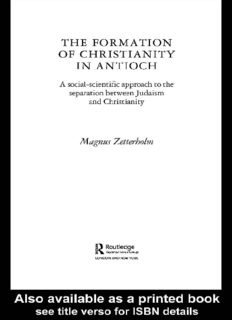
The Formation of Christianity in Antioch: A Social-Scientific Approach to the Separation between Judaism and Christianity PDF
Preview The Formation of Christianity in Antioch: A Social-Scientific Approach to the Separation between Judaism and Christianity
THE FORMATION OF CHRISTIANITY IN ANTIOCH THE FORMATION OF CHRISTIANITY IN ANTIOCH A social-scientific approach to the separation between Judaism and Christianity Magnus Zetterholm First published 2003 by Routledge 11 New Fetter Lane, London EC4P 4EE Simultaneously published in the USA and Canada by Routledge 29 West 35th Street, New York, NY 10001 Routledge is an imprint of the Taylor & Francis Group This edition published in the Taylor & Francis e-Library, 2003. © 2003 Magnus Zetterholm The author can be contacted directly at [email protected] All rights reserved. No part of this book may be reprinted or reproduced or utilised in any form or by any electronic, mechanical, or other means, now known or hereafter invented, including photocopying and recording, or in any information storage or retrieval system, without permission in writing from the publishers. British Library Cataloguing in Publication Data A catalogue record for this book is available from the British Library Library of Congress Cataloging in Publication Data Zetterholm, Magnus, 1958– The formation of Christianity in Antioch : a social-scientific approach to the separation between Judaism and Christianity / Magnus Zetterholm. p. cm. Includes bibliographical references and indexes. 1. Jewish Christians–Turkey–Antioch–History–Early church, ca. 30–600. 2. Religion and sociology–Turkey–Antioch–History. 3. Christianity and other religions–Judaism–History. 4. Judaism–Relations–Christianity–History. 5. Antioch (Turkey)–Church history. I. Title. BR195.J8 Z48 2003 275.64 (cid:1)01–dc21 2002033316 ISBN 0-203-44949-5 Master e-book ISBN ISBN 0-203-45780-3 (Adobe eReader Format) ISBN 0-415-29896-2 (Print Edition) TO KARIN, ANNA, MICHAEL, LINDA, SOFIA CONTENTS List of figures x List of abbreviations xi Acknowledgments xiii 1 Aim, method and perspectives 1 The aim of the study 1 The basic problem—from Jesus to Ignatius 1 J. D. G. Dunn and the partings of the ways 4 The aim specified 7 The method and perspectives of the study 8 Theories, perspectives and the question of verification 8 “The truth is out there”—textuality and meaning 8 Theories and perspectives 9 How do we know when we know? 11 The method of the study 13 A hermeneutical model of interpretation 13 Summary and conclusion 15 2 The setting: Antioch-on-the-Orontes 18 Introduction 18 A short history of Antioch 19 The foundation and early development of the city 19 From Antiochus IV Epiphanes to Titus 20 The social and religious life of Antioch 24 Antioch as a Greco-Roman polis 24 Public and private worship 25 Social conditions in Antioch 28 The Jewish community in Antioch up to 66 CE 31 The origin of Jewish presence in Antioch 31 vii CONTENTS The legal status of the Jews of Antioch 32 One community—several congregations 37 The internal organization of the Jewish community 38 The synagogue as a community center 39 Summary and conclusion 41 3 The cultural and religious differentiation 53 Introduction 53 Constructing analytical tools 55 A theory of religious differentiation 55 Religion and value-changing processes 55 Muslims and religious change in modern Europe 58 Pluralism and religious differentiation 61 A theory of social integration 67 Variables of assimilation 67 The process of assimilation 69 The assimilation profile—a test case 71 The use of acculturation 74 Analysis—Antiochean Judaism revealed 75 Groups and factions 75 Crossing the boundaries—Antiochus the apostate 75 Observing torah—religious traditionalists 80 Constructing alternatives—messianism and Hellenism 88 The synagogue and religious differentiation 91 Summary and conclusion 97 4 Evidence of interaction 112 Introduction 112 Riots and reactions 113 The incident at the circus 114 Antiochus, Titus and the Jews in Antioch 117 The paradox of attraction 121 Converts, admirers and god-fearers 121 Ethics, survival rates and the attraction of the Jews 124 Jews, god-fearers and civic authorities 127 The incident at Antioch 129 The scholarly debate 130 Purity and tithing 130 Circumcision and table-fellowship 131 Critique and revision 132 Circumcision and oath-taking 133 Christian identity 134 viii CONTENTS The need for a different approach 134 Covenant and conflict 136 The eschatological status of Gentiles 136 A covenant for Gentiles? 140 The agreement at Jerusalem and the apostolic decree 143 Who ate with whom—the issue of table-fellowship 149 Covenantal theology in the making 156 Summary and conclusion 164 5 Politics and persecution 178 Introduction 178 Constructing analytical tools 179 A theory of social movements 179 Social movements and collective action 179 The rationality of social behavior 180 The origin of social movements 181 The mobilization of resources 182 Social movements and social conflict 183 Analysis—the struggle for independence 185 The call for collective action 185 The socio-political situation after the Jewish war 185 Jews, Gentiles and the fiscus Judaicus in Antioch 190 The rationality of separation 193 Christianity as a social movement 203 Judaism, Christianity and Ignatius of Antioch 203 Resource mobilization and the Gospel of Matthew 211 Federations and the mission to the Jews 216 Summary and conclusion 222 Epilogue: summary and implications 231 The main results of the study 231 Implications 233 Bibliography 236 Ancient sources 236 Modern works 239 Indices 261 Index of passages 261 Index of subjects 269 ix
Description: